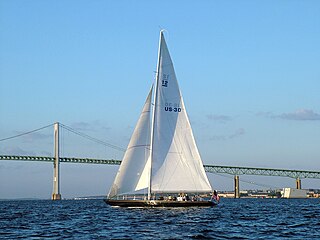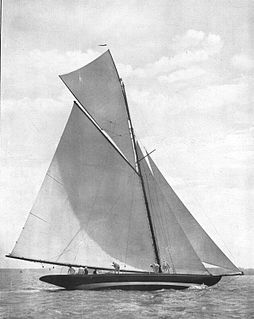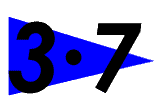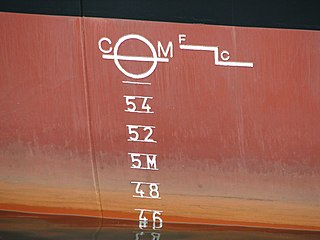
A hull is the watertight body of a ship or boat. The hull may open at the top, or it may be fully or partially covered with a deck. Atop the deck may be a deckhouse and other superstructures, such as a funnel, derrick, or mast. The line where the hull meets the water surface is called the waterline.

A maxi yacht usually refers to a racing yacht of at least 70 feet (21 m) in length.

The International 2.4mR is a one-person keelboat. The class is a development class governed by the 2.4mR rule. The rule is controlled by World Sailing (ISAF) since it is one of few classes designated as an International class. The class rule is closely related to the 12mR rule that was used in the America's Cup and the shape often resembles the larger sister.

EN 13402 Size designation of clothes is a European standard for labelling clothes sizes. It is based on body dimensions, measured in centimetres. It replaces many older national dress-size systems in popular use before the year 2007. Acceptance of this form of standardisation varies from country to country. For example, the Spanish Ministry of Health and Consumer Affairs has commissioned a study to categorise female body types with a view to harmonising Spanish clothing sizes with EN-13402. Few other countries are known to have followed suit. For children's clothing it is the de facto standard in most of Europe already.

The J/24 is an international One-Design keelboat class as defined by the International Sailing Federation. The J/24 was created to fulfill the diverse needs of recreational sailors such as cruising, one design racing, day sailing, and handicap racing.
One-Design is a racing method which may be adopted in sports which use complex equipment, whereby all vehicles, gliders or boats have identical or very similar designs or models. In motor racing, it is also known as Spec series, and one-make racing.

The 12 Metre class is a rating class for racing sailboats that are designed to the International rule. It enables fair competition between boats that rate in the class whilst retaining the freedom to experiment with the details of their designs. The designation "12 Metre" does not refer to any single measurement on the boat, and is not referencing the vessels overall length, rather, measures the sum of the components directed by the formula which governs design and construction parameters. Typically 12 Metre class boats range from 65 to 75 feet in length overall; they are most often sloop-rigged, with masts roughly 85 feet tall.
The Comet dinghy is a 16-foot-long (4.9 m), two-person, one-design class, racing sloop.
The International Offshore Rule (IOR) was a measurement rule for racing sailboats. The IOR evolved from the Cruising Club of America (CCA) rule for racer/cruisers and the Royal Ocean Racing Club (RORC) rule.

The beam of a ship is its width at the widest point as measured at the ship's nominal waterline. The beam is a bearing projected at right-angles from the fore and aft line, outwards from the widest part of ship. Beam may also be used to define the maximum width of a ship's hull, or maximum width including superstructure overhangs.

The International rule, also known as the Metre rule, was created for the measuring and rating of yachts to allow different designs of yacht to race together under a handicap system. Prior to the ratification of the International rule in 1907, countries raced yachts under their own national rules and international competition was always subject to various forms of subjective handicapping.
Ton classes are categories used to identify classes of yachts.

The International Seven Metre Class is a construction class, meaning that the boats are not identical but are all designed to meet specific measurement formula, in this case International Rule. At their heyday, Metre Classes were the most important group of international yacht racing classes, and they are still actively raced around the world. "Seven" in class name does not, somewhat confusingly, refer to length of the boat, but product of the formula; 7mR boats are, on average, 13 meters long.

The International Ten Metre Class is a construction class, meaning that the boats are not identical but are all designed to meet specific measurement formula, in this case International Rule. At their heyday, Metre Classes were the most important group of international yacht racing classes, and they are still actively raced around the world. "Ten" in class name does not, somewhat confusingly, refer to length of the boat, but product of the formula; 10mR boats are, on average, 16.5 meters long.
The International Nine Metre Class is a construction class, meaning that the boats are not identical but are all designed to meet specific measurement formula, in this case International Rule. At their heyday, Metre Classes were the most important group of international yacht racing classes, and they are still actively raced around the world. "Nine" in the class name does not, somewhat confusingly, refer to the length of the boat, but the product of the formula; 9mR boats are, on average, 18 meters long.

The IYRU Fifteen Metre class yachts are constructed to the First International rule of 1907. A total of twenty 15mR yachts were built between 1907 and 1917, the four that have survived are still actively raced.

The Transpac 52 (TP52) is a class of yacht used for competitive yacht racing. The class is recognised by the International Sailing Federation which entitles the class to hold an Official World Championships.

The Farr 3.7 is a one-person sailing dinghy designed by Bruce Farr in 1971. The design plans are sold by the 3.7 Class Owners Association and they are built by a mix of professionals and home built by amateurs. The 3.7 Class is recognised by Yachting New Zealand as a national class and yachts are sailed in New Zealand, Australia and Great Britain. Full sets of plans have been sold worldwide to a number of individuals with greatest numbers in Germany, Japan, USA, South Korea, Poland, France, Belgium.
Handicap forms for sailing vessels in sailing races have varied throughout history, and they also vary by country, and by sailing organisation. Sailing handicap standards exist internationally, nationally, and within individual sailing clubs.
















